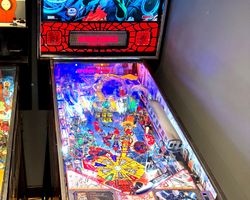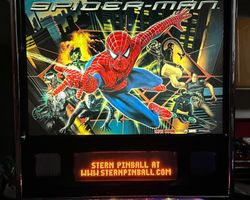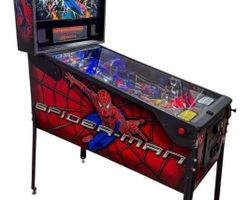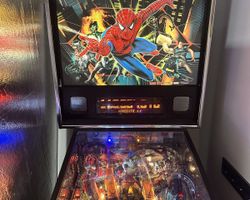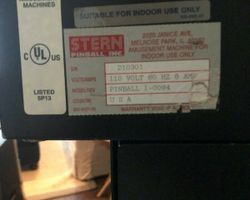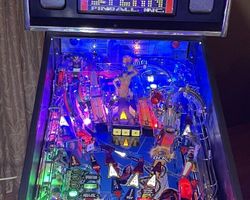Spider-Man™
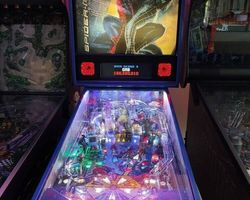
Average Prices: USD $2,200 to $6,300
Produced: June, 2007
Machine Type: Solid State Electronic
MPU: Stern S.A.M. Board System
Players: 4
Concept by: Steve Ritchie, Lyman F. Sheats Jr.
Design by: Steve Ritchie
Art by: Kevin OConnor, Margaret Hudson, Mark Galvez, Marc Schoenberg
Dots/Animation by: Mark Galvez
Mechanics by: John Rotharmel, Rob Blakeman, Mike Redoble
Music by: David Thiel
Sound by: David Thiel
Software by: Lyman F. Sheats Jr.
Pinball machines based on popular media properties often face the challenge of translating a rich narrative into a playable experience. The "Spider-Man" pinball machine, released by Stern Pinball in June 2007, tackled this by drawing from the cinematic interpretations of the webslinging superhero. Designed by Steve Ritchie, with software by Lyman F. Sheats Jr., music and sound by David Thiel, and art by Kevin O'Connor, Margaret Hudson, and Mark Galvez, the machine aimed to immerse players in the world of Peter Parker and his rogue's gallery.
The development of "Spider-Man" was a collaborative effort, bringing together several key figures in modern pinball. Steve Ritchie, a designer known for his fast-flowing layouts and challenging shots, laid the foundation for the machine's dynamic play. Lyman F. Sheats Jr. developed the intricate software and rules, contributing to the strategic depth often associated with his work. The artistic team captured the visual essence of the films, while David Thiel crafted a soundscape to match the theme's high energy. With 3,760 units produced in its initial run, and a later "Red-Suit" production in July 2010, "Spider-Man" became a significant release for Stern, showcasing their commitment to licensed titles and establishing its presence in collections and arcades. A subtle nod to pinball history exists within "Spider-Man"; Steve Ritchie, a known admirer of Brian Eddy's "Attack From Mars," incorporated a motorized target bank for the Sandman character, directly inspired by Eddy's innovative design. Ritchie had envisioned a more complex, variable-speed Green Goblin toy to enhance difficulty, but production realities led to a simpler, single-speed "twitching" mechanism, later refined by Lyman Sheats Jr. to perform multiple twitches.
Signature Features and Design
"Spider-Man" distinguishes itself with several interactive features that bring its thematic elements to life on the playfield. Central to the experience is the Doc Ock bash toy, equipped with a motor that moves it up and down and a magnet that can seize and hold the ball, simulating his "Fusion Malfunction" from the films. This physical interaction creates a tense moment, enhancing the sense of danger and urgency.
The Green Goblin is represented by a motorized figure hovering above a set of Pumpkin Bomb targets. Hitting these targets activates the Goblin, challenging players with a moving shot that demands precision. On the left side of the playfield, the Venom ramp quickly returns the ball to the left flipper, facilitating rapid shot chaining and maintaining the game's brisk pace.
Perhaps the most dynamic feature is the Sandman's presence in the center of the playfield. This motorized three-bank of targets can lower, revealing a shot behind them. This mechanism, a direct homage to classic pinball innovation, constantly changes the accessible shots and objectives, adding a layer of strategic depth as players decide whether to clear the targets or aim for the newly revealed path. These three motorized toys—Doc Ock, Green Goblin, and Sandman—visually populate the playfield with moving elements, making the game feel alive. The robust sound package, including custom speech, particularly the acclaimed callouts from J.K. Simmons as J. Jonah Jameson, further immerses players with humor and thematic reinforcement. For enthusiasts, an optional shaker motor kit could be installed, providing tactile feedback that synchronized with gameplay events, deepening the physical engagement.
Playfield and Mechanics
The "Spider-Man" playfield layout exemplifies Steve Ritchie's signature design philosophy, characterized by fluid shots and high-speed action. It features three ramps, three flippers (including an upper right flipper), three bumpers, and a central magnet, creating a dense yet navigable environment. The layout encourages a "shooter" style of play, where precise shots are rewarded with satisfying returns and combo opportunities.
The primary shots are thoughtfully integrated: the left Venom ramp provides a quick return for continuous play, while the main right ramp sends the ball to a wireform, setting up further shots. The Doc Ock bash toy, positioned strategically to the left of the playfield's center, often serves as a key objective, with its magnet adding an unpredictable element to ball behavior. To the right, the Green Goblin targets require careful timing as the figure moves erratically. In the center, the Sandman's motorized three-bank drop targets are pivotal; hitting them causes them to lower, opening up new scoring opportunities and changing the flow of the game.
The upper right flipper is crucial for accessing specific shots, notably the Green Goblin targets and sometimes a ramp return. Mastering this flipper is essential for maximizing scores and progressing through modes. The artwork, while thematically consistent with the movie aesthetic, often drew criticism for its reliance on photographic elements and its overall "photoshopped" appearance, with some finding it dated or lacking in original artistic expression. Despite this, the integration of lighting, particularly when upgraded with LEDs, significantly enhances the visual appeal and draws attention to key playfield features, contributing to the overall aesthetic experience.
Gameplay Dynamics
The gameplay dynamics of "Spider-Man" prioritize accessible fun combined with strategic depth. The ruleset, developed by Lyman F. Sheats Jr., is designed to be easily understood by new players while offering layers of complexity for experienced enthusiasts seeking high scores. The primary objective revolves around defeating Spider-Man's key adversaries: Doctor Octopus, Sandman, Venom, and Green Goblin. Each villain initiates a unique mode with specific objectives that players must complete by hitting designated shots.
Progression through the game involves advancing through these villain modes, collecting "Spider Sense" awards, and building up scores through various multipliers and combo chains. Multiball is a central feature, with the machine capable of launching four balls into play simultaneously. These multiball phases are crucial for accumulating high scores and can often be stacked with active villain modes, creating chaotic yet rewarding scoring opportunities.
Unique challenges include the Web Swinging mechanic, which typically involves alternating ramp shots to simulate Spider-Man's aerial movements. The game features multiple wizard modes that serve as culminations of player effort. "Super Hero" acts as a mini-wizard mode, offering a significant challenge, while "Battle Royale" is the ultimate wizard mode, demanding mastery of all the game's mechanics and a deep understanding of its rules. Successfully reaching and completing these modes provides a fulfilling sense of accomplishment. Player strategies often involve prioritizing the activation and stacking of multiball with villain modes, utilizing the fast flow to chain shots, and mastering the tricky upper flipper shot to efficiently defeat the Green Goblin.
Reception and Legacy
Upon its release, "Spider-Man" by Stern Pinball garnered a largely positive reception within the pinball community, solidifying its place as a contemporary favorite. Its strengths were frequently highlighted, particularly its gameplay and flow. Players consistently praised its fast-paced nature, the smoothness of its shots, and the satisfying feeling of hitting combos. It earned a reputation as a "shooter" machine, emphasizing skill and precision over complex rule memorization, which appealed to a broad audience from casual players to seasoned competitors. This approachable yet deep design contributed to its high replay value, often eliciting the "one more game" sentiment.
The integration of the Spider-Man theme was another significant strength. Fans of the character and the films found the machine's representation compelling, with effective use of the villains and movie-based modes. The custom callouts, especially those by J.K. Simmons reprising his role as J. Jonah Jameson, were particularly well-received for their humor and authenticity, adding another layer of immersion. The ruleset, while accessible, offered enough depth through stacked objectives and distinct multiball modes to keep advanced players engaged for extended periods. The interactive toys—Doc Ock with his magnet, the dynamic Sandman, and the moving Green Goblin—were generally well-executed and contributed positively to the overall experience.
However, "Spider-Man" was not without its criticisms. The most frequent point of contention was the playfield artwork. Many described it as "photoshop heavy," "mediocre," or "dated," feeling that it relied too much on promotional imagery from the films rather than original pinball art. Some felt it lacked visual cohesion and that the layout didn't leave enough "space for actual artwork." The Dot Matrix Display (DMD) animations also drew some criticism for being grainy, though others found them acceptable for spectating. A few players also noted that the rules, while engaging, could become somewhat repetitive over long play sessions, with a focus on hitting the same primary shots. The visual prominence of the Sandman character on the playfield was a minor point of contention for some. Additionally, the shooter lane design was occasionally cited as being prone to wear over time.
Despite these critiques, "Spider-Man" has maintained a strong legacy. It is widely considered one of Stern Pinball's most successful and enduring licensed titles, often appearing on lists of "best modern pinball machines." Its combination of accessible yet deep gameplay, robust features, and strong thematic integration positioned it as a benchmark for future licensed designs. Steve Ritchie's signature flow, combined with Lyman F. Sheats Jr.'s deep code, created a machine that continues to be celebrated for its replayability and fun factor, influencing subsequent designs by demonstrating the commercial viability and artistic potential of well-executed movie-themed pinball machines.
Sponsored Links
 Ebay Listings
Ebay Listings
 Auction Results
Auction Results
| Cost | Location | Date |
|---|---|---|
| GBP £3,688 |  Ipswich, United Kingdom Ipswich, United Kingdom |
24 September, 2025 |
| USD $7,299 |  California, United States California, United States |
24 May, 2025 |
| USD $3,020 |  Arizona, United States Arizona, United States |
14 January, 2025 |
| USD $6,100 |  Iowa, United States Iowa, United States |
11 August, 2024 |
| USD $5,600 |  California, United States California, United States |
22 March, 2024 |
| USD $5,500 |  Colorado, United States Colorado, United States |
17 February, 2024 |
| USD $5,800 |  Pennsylvania, United States Pennsylvania, United States |
06 January, 2024 |
| USD $5,400 |  Pennsylvania, United States Pennsylvania, United States |
28 December, 2023 |
| EUR €4,387 |  Saarland, Germany Saarland, Germany |
26 August, 2023 |
| USD $6,350 |  New Hampshire, United States New Hampshire, United States |
30 May, 2023 |


Private Policy · Search Website · Contact Us
As an eBay Partner, we may earn a commission from qualifying purchases made through links on this site, at no additional cost to you.
All trademarks and copyrighted materials remain property of their respective owners. All other content copyright 2007 - 2025 Pinpedia.

